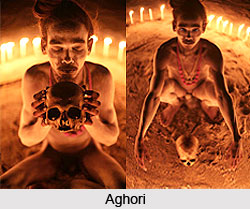 Aghori is a class of Shaiva mendicants. Aghori sect is an ancient sect and their references are found in the Sanskrit drama `Malati Madhava.` The Aghori sect is believed to split off from the Kapalika order, which dates from 1000 CE in the fourteenth century AD. It required even human victims for its performance. The diet after the Puja includes flesh and spirituous liquors. The Aghori sect is said to be closely associated with the Kapalika sect of the Middle Ages. It was common belief regarding Aghori sect that they can freely assume the shapes or an animal, bird or a fish. However, the regular worship of this sect has been restrained since along time.
Aghori is a class of Shaiva mendicants. Aghori sect is an ancient sect and their references are found in the Sanskrit drama `Malati Madhava.` The Aghori sect is believed to split off from the Kapalika order, which dates from 1000 CE in the fourteenth century AD. It required even human victims for its performance. The diet after the Puja includes flesh and spirituous liquors. The Aghori sect is said to be closely associated with the Kapalika sect of the Middle Ages. It was common belief regarding Aghori sect that they can freely assume the shapes or an animal, bird or a fish. However, the regular worship of this sect has been restrained since along time.
Some traces of this Aghori worship is now left among few disgusting wretches. They confess to have adopted its beliefs just for extracting alms. They do not cook but eat and drink whatever is given to them even ordure and carrion to prove their indifference from worldly objects. They smear their bodies also with excrement. The Aghori sect used to carry it about with them in a wooden cup or skull either to swallow it or to throw it upon the persons or into the houses of those who refuse to comply with their demands. They also for the same purpose impose wounds of their limbs that the crime of blood may rest upon the head of the recusant. They also have a variety of similar repulsive devices to extort money from the timid and innocent people. It is also said that when angered and excited, the Aghoris invoke Goddess Kali and warn to spread devastation all around. They were universally disliked and feared by the people.
The Aghori are said to have their origin to Kina Ram, an ascetic who is said to have lived 150 years back. Kina Ram is believed to have been an incarnation of Lord Shiva. The main akhada of the Aghoris is in Varanasi in Kina Ram`s hermitage and also at Girnar near Mount Abu. The Aghoris differentiate themselves from other Hindu sects and priests by their alcoholic and cannibalistic rituals. They collect the corpses floating on the Ganga River and consume them raw as the Aghoris believe it gives them immortality and supernatural powers.




















